Back to the list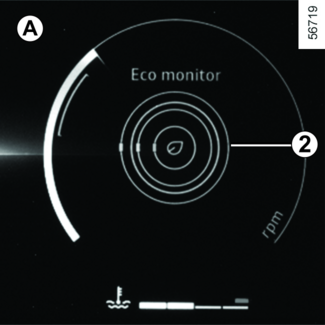
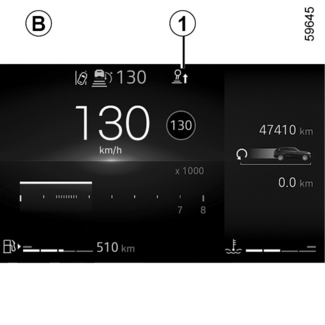
 shift up a gear ;
shift up a gear ;
 downshift a gear.
downshift a gear.

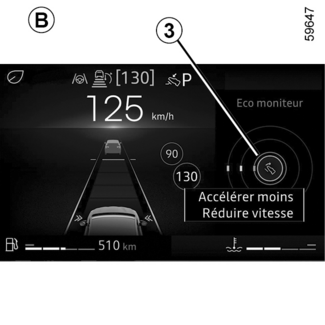
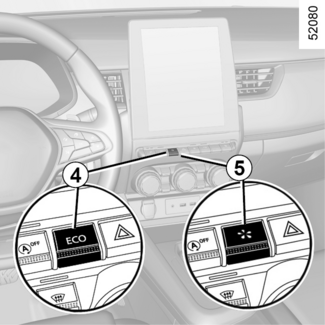
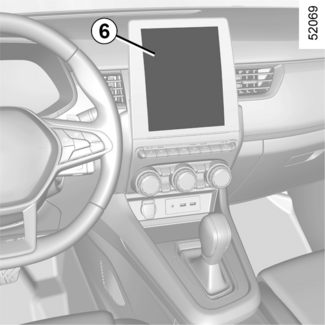

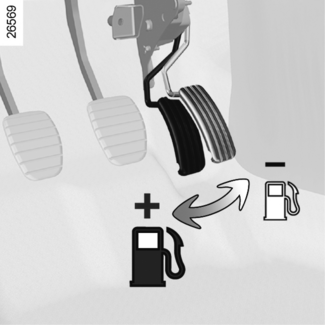
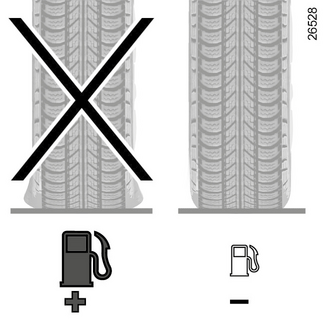
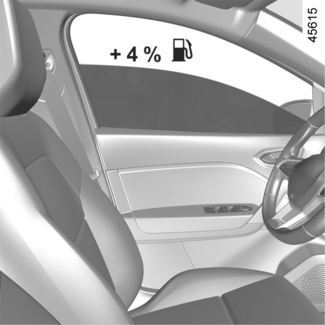
Driving advice, eco driving
Driving advice, eco driving
Fuel consumption is accredited in accordance with a standard regulatory method. Identical
for all manufacturers, this enables vehicles to be compared with one another.
Consumption in real time depends on vehicle usage conditions, the equipment fitted
and
the user’s driving style. To optimise fuel consumption, please refer to the following
advice.
Depending on the vehicle, you will have various functions which enable you to lower
your
fuel consumption :
- the rev counter ;
- gear change indicator ;
- the driving style indicator ;
- the journey record and eco-driving advice via the multimedia screen ;
- acceleration indicator Eco ;
- ECO mode ;
- the Stop and Start function; STOP AND START FUNCTION
- Charge meter for E-Tech full hybrid vehicle.
If fitted on the vehicle, the navigation system provides additional information.
On the instrument panel A or B

Depending on the vehicle, the information display can be organised and customised
based
on the instrument panel customisation style selected from the multimedia screen.

Gear change indicator 1
Depending on the vehicle, to obtain optimum consumption levels, a warning light on
the
instrument panel lets you know the best time to move up or down a gear :
If you regularly follow this indicator, you will reduce your vehicle’s fuel
consumption.

Driving style indicator 2
Informs you about the driving style adopted in real time. This is shown by indicator
light 2.
The more petals displayed on 2, the more your driving is flexible and
economical.
If you regularly monitor this indicator, you will reduce your vehicle’s fuel
consumption.
Please refer to the multimedia instructions for further information.

Acceleration indicator Eco3
This informs you in real time whether you are accelerating moderately or strongly.
This is shown by the 3 warning light :
- green : acceleration is moderate and correct ;
- white : acceleration is too high ;
- grey : acceleration is high.
Note : it is not possible to simultaneously display the driving style indicator
2 and the Eco
acceleration indicator 3.
ECO mode
ECO mode is a function which optimises fuel consumption. It acts upon certain power consuming
systems in the vehicle (heating, air conditioning, power-assisted steering, etc.)
and on certain driving actions (acceleration, gear changing, cruise control, deceleration,
etc.).
Limiting acceleration enables low fuel consumption in urban and surrounding areas.
Reduced usage of the air conditioning reduces fuel consumption without affecting heating
comfort.
Free wheel in ECO mode (or My Sense mode depending on the vehicle)
Depending on the vehicle, for vehicles fitted with an automatic gearbox, in the deceleration
phases (with the foot fully off the accelerator pedal), switching to freewheeling
(automatic neutral) decreases engine braking and allows you to farther without accelerating
in order to save fuel.
To activate/deactivate “Free wheel” mode, refer to the multimedia instructions.

Activating the function
Depending on the vehicle, the function can be activated either :
- by pressing the 4 switch ; MULTI-SENSE
- by pressing switch 5 ;
- from the multimedia screen (refer to the multimedia equipment instructions).
The warning light  comes on on the instrument panel to confirm activation.
comes on on the instrument panel to confirm activation.
While driving, it is possible to leave the ECO mode temporarily in order to improve engine performance.
To do this, press the accelerator pedal firmly and fully.
ECO mode is reactivated when you take pressure off the accelerator pedal.
Disabling the function
Depending on the vehicle, the function can be deactivated either :
- by pressing the 4 switch ; MULTI-SENSE
- by pressing switch 5.
The warning light  goes out on the instrument panel to confirm deactivation.
goes out on the instrument panel to confirm deactivation.
On the multimedia screen

Journey record
Once the engine is switched off, you will see “Journey record” displayed on the multimedia
screen 6, enabling you to view information on your last journey.
This indicates :
- the general score ;
- score evolution ;
- distance without fuel consumption.
Please refer to the multimedia instructions for further information.
An overall rating from 0 to 100 is displayed to let you assess your eco driving performance.
The higher the rating, the lower the fuel consumption.
Eco advice is given to help improve your performance.
With your favourite journeys saved, you can compare your performance between trips
and the performance of other vehicle users.
Charge meter

(on the instrument panel)
The charge meter gives the driver a real-time view of the vehicle’s energy consumption.
Blue “Energy recovery” A usage zone
During driving, if you lift your foot off the accelerator pedal or press the brake
pedal, the electric motor generates electrical current during deceleration and this
energy is used to slow down the vehicle and recharge the traction battery.
“Energy consumption” B use area
The colour of the charge meter varies :
- in green : all-electric mode, the traction battery provides the energy required for the electric motor to power movement of the vehicle ;
- in white : hybrid traction mode, the traction battery and/or the combustion engine provide the energy required to power movement of the vehicle.
Maintaining the traction battery charge level : “E-save”
Available from your multimedia screen in two ways :
-activation/deactivation from the “Vehicle Settings” menu ;
-positionable widget on the home page.
This mode enables you to maintain a sufficient charge level in the traction battery
in anticipation of a mountain road or a long motorway slope.
Driving advice and ECO driving

Behaviour
- Drive carefully for the first few miles until the engine reaches its normal operating temperature, rather than let it warm up while the vehicle is stationary.
- High speeds significantly affect the vehicle’s fuel consumption.
Examples (at a steady speed) :
- reducing the speed from 80 mph (130 km/h) to 68 mph (110 km/h) approximately saves up to 20 % of fuel approximately ;
- reducing the speed from 56 mph (90 km/h) to 50 mph (80 km/h) approximately saves up to 10 % of fuel approximately.
- Dynamic driving with a lot of frequent acceleration and braking is expensive on fuel in comparison to the time saved.
- Do not over rev the engine in the intermediate gears. You should always use the highest gear possible.
- Avoid sudden acceleration.
- Brake as little as possible. If you anticipate an obstacle or bend in advance, you may then simply release the accelerator pedal.
- Do not try to maintain the same speed up a hill, accelerate no more than you would on the level. Keep your foot in the same position on the accelerator pedal.
- Double declutching and accelerating before switching off are unnecessary in modern vehicles.
- Bad weather, flooded roads :
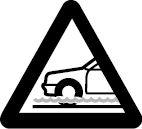 | Do not drive through floods if the water is above the lower edge of the wheel rims. |
Heating level
It is normal to notice an increas in the vehicle’s fuel consumption when using the
heating (particularly when the outside temperature drops below zero) or air conditioning.
WARNING
Obstructions to the driver
On the driver’s side, only use mats suitable for the vehicle, attached with the pre-fitted
components, and check the fitting regularly. Do not lay one mat on top of another.
There is a risk of wedging the pedals

Tyres
- An underinflated tyre increases fuel consumption.
- To optimise fuel consumption, set the highest speed tyre pressure or the recommended pressure indicated on the edge of the driver’s door. TYRE PRESSURE
- The use of non-recommended tyres can increase fuel consumption.

Advice on use
- Favour the ECO mode.
- Electricity is fuel ; switch off all the electrical components which are not really needed. However (safety first), keep your lights on when the visibility is bad (“see and be seen”).
- Use the air vents. Driving with the windows open at 60 mph (100 km/h) will increase fuel consumption by 4 %.
- Never fill the fuel tank right to the brim to avoid overflow.
- On vehicles equipped with non-automatic air conditioning, switch off the air conditioning when it is not required.
Advice for reducing consumption and therefore helping to preserve the environment :
If the vehicle has been parked in the sun, open the doors for a few moments to let
the hot air escape before starting the engine.
- Do not leave an empty roof rack fitted to the vehicle.
- It is better to fit a trailer for bulky objects.
- When towing a caravan, fit a wind deflector and adjust it carefully.
- Avoid using the car for door-to-door calls (short journeys with long waits in between) because the engine never reaches its normal operating temperature.